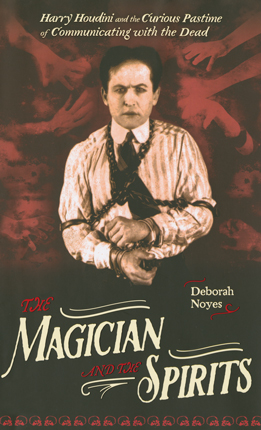Full Text Reviews: Booklist - 06/01/2017 Plenty has been written about Houdini’s iconic escape routines and stage magic, but in this biography, Noyes focuses on a lesser-known facet of his career: his mission to debunk spiritualists. After his mother died, Houdini wanted to believe in the possibility of contact from beyond the grave. But his career gave him singular insight into tricks mediums deployed during seances, and, angered by the thought of mediums swindling grief-stricken people, he became determined to reveal the fakery of spiritualism. While describing Houdini’s campaign to unmask fraudulent mediums, Noyes offers compelling tidbits about the many ways spiritualists performed their tricks, and helpful historical context for the popularity of spiritualism. Houdini’s feud with avowed spiritualist Arthur Conan Doyle is particularly fascinating, though the details of their clash get a bit lost. Still, there’s plenty of intriguing information here, often in eye-catching inset boxes with additional background, and Noyes’ attention to Houdini’s outsize personality—a key component of his campaign against spiritualists—adds compelling depth. A worthwhile addition to any nonfiction section, and ideal for kids intrigued by historical oddities. - Copyright 2017 Booklist. School Library Journal - 07/01/2017 Gr 6 Up—Harry Houdini is best remembered as a magician and escape artist, but he also spent more than half his life tirelessly investigating mediums and séances—charlatans in disguise. Noyes's narrative blends the history of the spiritualism movement in the early 20th century with a biographical account of Houdini. Early in Houdini's career, between 1897 and 1899, he and his wife Bess performed as mediums and mind readers, but he later wrote that he regretted "trifling with the hallowed reverence which the average human being bestows on the departed." Influenced by the loss of his beloved mother in 1913 and his ongoing debate with friend and avid spiritualist Sir Arthur Conan Doyle, Houdini embarked on a mission to debunk spiritualism, which by 1924 "had become a full-on crusade." Noyes stresses that Houdini believed in an afterlife and probably hoped that communication with the dead was possible but he never found legitimate evidence. Since magic acts and fraudulent séances made use of many of the same methods, Houdini was adept at discovering trickery, which he exposed most notably in a 1924 lecture tour. Houdini is portrayed as a likable figure, motivated by his compassion for grieving people and respect for the deceased. The title has an appealing layout with frequent sidebars, copious photographs and archival theater posters, and a page border that subtly contributes to the book's Victorian flavor and spooky mood. Although some passages are a bit dry, the read is overall intriguing and likely to hook students. VERDICT Fans of magic, mystery, and debates on the supernatural will devour Noyes's take on Houdini.—Magdalena Teske, Naperville Public Library, IL - Copyright 2017 Publishers Weekly, Library Journal and/or School Library Journal used with permission. Loading...
|





